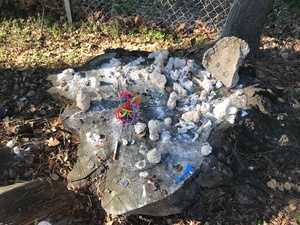Local Ghost Stories of Dubious Truthfulness
The Williams' House
Tucked away in Davis, California, a small college town northeast of San Francisco, lies the site of one of the most brutal murders in American history. As one passes along the quiet, tree-lined street, the Williams house seems to fade into the background -one would never guess that 11 people were butchered in this small, unassuming residence.
The year was 1946 and Davis was in the midst of change. Historically a farming town, Davis had long been dominated by sprawling farms and ranches, but after the founding of University Farm in 1905 (Now known as the University of California, Davis) the town’s population had steadily risen. This rising population called for more housing, and suburbs began appearing along Russell Boulevard and the surrounding areas.
Jonathan Williams, born November 17th, 1910, was a college professor and acclaimed botanist who moved to Davis with his wife, Eleanor, and six year old twin girls, Nancy and Opal. The young family moved to Douglass Avenue, in the midst of the newly constructed suburbs, where they began to settle in.
Williams, eager to prove his worth, began spending long hours working at the University laboratory, where he sought to improve the shelf life of tomatoes through selective breeding and cutting-edge soil additives. Prone to jealousy, Eleanor began to suspect that Jonathan had other, more carnal motives for staying out so late most nights of the week.
On February 23rd, the twins' birthday, Eleanor was excited and eager to please her daughters. She worked tirelessly throughout the day, decorating the house and preparing food for the girls party that night, but as dusk began to fall and guests started to arrive, there was still no sign of Jonathan. Eleanor kept her chin up and put on a façade of gaiety for the guests and her children, but as more hours passed, her husband’s conspicuous absence became too much for her pride to bear. She would teach him that there were consequences for infidelity. She slipped into the kitchen, and emptied a container of arsenic into the cake batter. Later, as the children gathered around the table, donning party hats and blowing noisemakers, Eleanor started singing from the kitchen as she brought the cake into the room. The rest joined in and shadows cast from the flickering candles piercing the white frosting, danced across her stoic face.
Hours later, the guests were writhing on the floor, having consumed a nonlethal dose of arsenic, yet enough to incapacitate them. Eleanor felt that she had failed, so she went into the garage, where she found an old hammer which she used to finish them off, one by one. Apparently this was not enough, as she proceeded to hang the bodies on meat hooks hung from the living room ceiling, where she sat and waited for her husband's arrival wearing her wedding dress drenched in blood, perhaps to remind him of the sacred oaths he had broken.
The ghosts of the twin girls have been reported to peer through windows of neighboring houses. —Davishistorian
The Werner-Hamel House
Shrouded by trees in the Willowcreek Neighborhood of South Davis stands the Werner-Hamel house. The house is the oldest structure in Davis; it was built in 1859, less than a decade after California became a state. The home was originally built South of Davis in Solano County, where it was purchased by German immigrant Hartman Hamel in 1869, and became the center of the largest local cattle ranching operation. According to oral tradition, the Hamels were ruthless businessmen and worked many of their farm laborers to death. The family home was eventually relocated to its current lot in Davis, supposedly in an attempt to escape the blood soaked Solano location, which had become haunted by the vengeful spirits of the deceased workers.
The move seems to have not succeeded in eradicating the troublesome spirits, as several members of the Hamel family were found deceased on the site in the early 1900’s, throats slit and mouths crammed full of the bank notes they had been paid as their profits from running the cattle ranch. By 1920, the remainder of the Hamel family relocated elsewhere in Davis. Shortly after the house was vacated, a large group of vultures took up residence in the trees above the house and remain there to this day,
Recent Developments:
- As of January 2020, a large group of vultures roost above the house (vultures are considered to be psychopomps, creatures that bridge that gap between the world of the living and the world of the dead).
- As of January 2021, a witch's stump altar has been erected along the greenbelt outside the house (no, seriously). Superstitious Davisites can take solace in the fact the provided offerings seem as though they would be insufficient to summon any self-respecting malicious spirit.
- Despite being valued at $1,350,000, the Werner-Hamel House was last sold for $30,000 in 2000, presumably due to the detrimental effect ghosts have on property values.
- Residents of Willowcreek report shadowy figures wandering the greenbelt along Putah Creek near the house after dark. The inconsiderate apparitions appear to have minimal concern for posted park hours, as signs clearly state the greenbelt does not allow loitering after sunset.
 Witch's Stump Altar with offerings of... Like a buck in change and a cigarette?
Witch's Stump Altar with offerings of... Like a buck in change and a cigarette?  Solomon's seals we are not.
Solomon's seals we are not.



